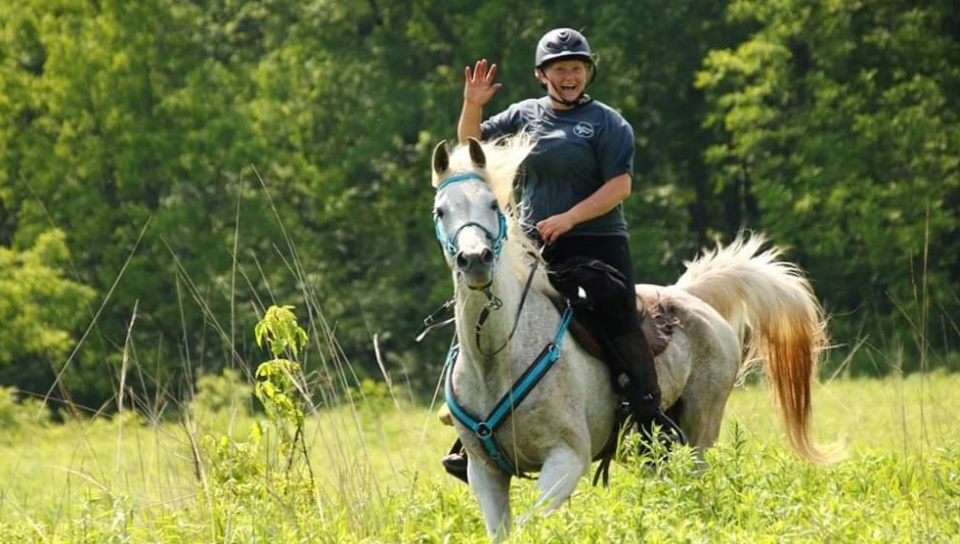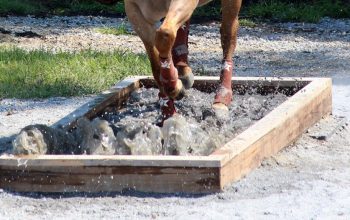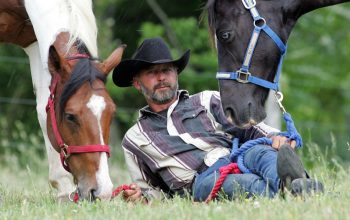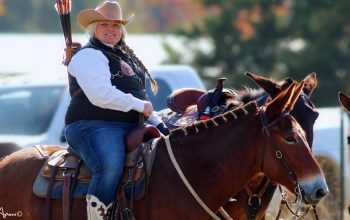AERC’s 2019 National Limited Distance Best Condition winner shares her story of starting an older horse in endurance riding
By Samantha Miller
There is a saying: “You can’t teach an old dog new tricks.” I like to believe “we are only as old as we act” to be truer, from what I have experienced with my 22-year-old Arabian gelding Gilligan. This past year he took the national best condition award in limited distance with seven best conditions, 10 firsts and two seconds.
Something most people don’t know about Gilligan is that he had very little trail riding experience until he was 18. We have been together for 20 years. We started our journey in the Arabian show ring, which didn’t work out.
I never heard the term “race brain” until I started learning about this sport and he is the textbook definition. So, if you can picture that race-brain horse you see on trail in an arena of 30 other horses going around at a hand gallop, it isn’t pretty. At home by ourselves, you’d think we had a chance to make it to nationals. His movement and presence are beautiful and eye-catching, but when we got to a show all he wanted to do was catch that next horse.
We tried for four years before switching to dressage, which he did really well. At this time I turned 18 and my parents said that if I wanted to keep competing it was my financial responsibility. As you can guess that was our end of showing. Throughout college and while starting my career, he just sat in the pasture and we enjoyed a few rides when I could get home.
Fast forward to 2015-2016: I moved back on the farm and was able to bring my horses with me. I no longer had access to an arena, but I do have 12 miles of trails at my disposal right out my door. It was a slow start. There was a lot of trust that had to built on both our parts. Even the thought of riding him on a loose rein was hard to wrap my mind around. He is strong, huge mover and I thought if he wasn’t collected he would have the idea of unbridled freedom and be uncontrollable.
The first month we spent walking the same mile-and-a-half loop. This is about the time my friend Linda started coming over with her endurance horses, and after our first ride together she planted the idea of giving distance a chance with him.
Honestly, I thought she was crazy. He was 17 at the time, with minimal trail exposure, and I was convinced that if I were to ask him to do anything but walk I’d never get him to stop. From here Gilligan and I spent probably a year just walking our 12 miles of hills, getting to know each other on a new level. Then one spring afternoon everything just clicked.
I’ll never forget the feeling of that moment he and I became a “we.” Halfway through our ride we came to one of our long hills. I leaned forward and said “OK.” Somehow he knew, and at that moment we flew. My fear of never getting him to walk again vanished—why walk when you have wings?
No worries, he does walk (sometimes). That summer we attended our first ride, signing up for the Friday LD not having a clue what to expect once other horses came into play. Linda was there for us and I’m convinced we would have never survived without her.
To say we were hooked would be an understatement. Gilligan has never been happier than when he is on trail at rides. My takeaway: If you are starting an older horse in this sport, start slow. Their minds and bodies have been programmed all those years one way and it is hard to modify some of those old lessons that were drilled into them. I would compare it to NASCAR racing. Those drivers have been running at high speeds, always turning left; now imagine asking them to turn around and race turning right.
Gilligan still struggles with realizing he can eat with a bit in and while I am on him. It is frustrating, but I can’t blame him. In our show barn eating with a bit was a hard no. Having a friend/mentor with knowledge of competing on senior horses is worth its weight in gold. When we got started, Linda was successfully competing on three horses, all in their mid to upper twenties. My final parting thought: if your horse is healthy and enjoys what he is doing, trot on!
 Learn more about the American Endurance Ride Conference (AERC) >
Learn more about the American Endurance Ride Conference (AERC) >




